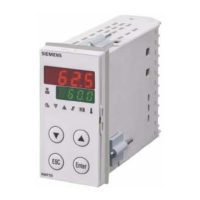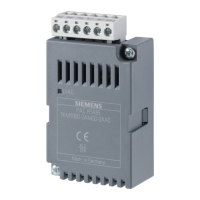38/126
Siemens Building Technologies Basic documentation RVD240 CE1P2384en
HVAC Products 11 Function block Plant configuration 27.05.2004
T
AM
T
V
2383D08e
100
90
80
70
60
50
40
30
20
20
15
10 5
0
-5 -10
10
0
Range 1 Range 2
n
red
n
max
T
R
for n
red
T
R
for n
max
T
HKm
A
B
C
T
V
for n
red
T
V
for n
max
T
Vmax
= 70 °C
A Operating point A (maximum pump speed reached) T
HKm
Mean radiator temperature
B Operating point B (theoretical heat output) T
RL
Return temperature
C Operating point C (effective heat output) T
V
Flow temperature
n
max
Maximum pump speed
n
red
Reduced pump speed
T
Vmax
Maximum limit value of flow tempera-
ture
Notes on the example given in the illustration:
• The heating plant is designed such that it reaches its maximum capacity at an outside
temperature of –10 °C (no more spare capacity for heating up processes). At this
outside temperature, both the pump speed and the flow temperature are at their
maximum
• With this kind of plant design, it can be assumed that the outside temperature hardly
ever drops below –5 °C. But the pump speed will also be increased above its minimum
in the case of heating up processes, when the outside temperature is above –5 °C
Lower pump speeds mean:
• Energy savings due to reduced pumping power
• Greater differential between heating flow and return temperature
• Lower return temperatures
The heating circuit is controlled based on the signal received from the heating circuit
flow sensor.
Setting of the maximum flow temperature (operating line 95) defines the maximum flow
temperature setpoint on the one hand. On the other, the same setting defines the range
from what flow temperature the pump speed shall be increased.
The maximum flow temperature should always be selected as high as this is permitted
by the heating system. The higher the flow temperature setting, the longer the pump
runs at minimum speed. Also, the heating circuit’s maximum output will not be re-
stricted unnecessarily.
The illustration shows that at outside temperatures below operating point C, the pump
speed will be increased from minimum to maximum. To define the rate at which the pump
speed shall be increased, the radiators’ power factor is to be set. The power factor is the
ratio of radiator output at minimum pump speed and that at maximum pump speed:
Radiator output at minimum speed
Power factor =
Radiator output at maximum speed
The factory setting is 85 %. If the plant is correctly sized, this setting ensures a satisfac-
tory performance and, for this reason, necessitates readjustments only in exceptional
Maximum flow tempera-
ture
Power factor

